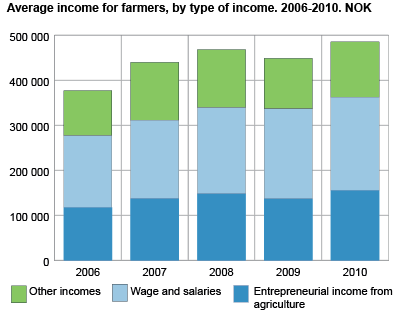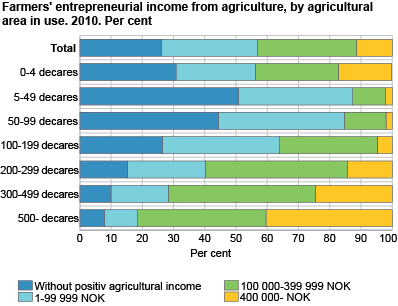Content
Published:
This is an archived release.
Farmers’ incomes increased by 8 per cent
On average, gross income for farmers amounted to NOK 485 000 in 2010. This represents an increase of NOK 36 000, or 8 per cent, from the previous year. Entrepreneurial income from agriculture increased by NOK 19 000 and amounted to an average of NOK 155 000 in 2010.
Agricultural holdings vary considerably in size, from hobby-like production to holdings with a turnover of more than NOK 1 million. This is the main reason for the considerable variation in entrepreneurial income from agriculture. In 2010, the farmers’ personal income from wages and pensions amounted on average to NOK 237 000, total entrepreneurial income amounted to NOK 214 000 and capital income amounted to NOK 34 000. Average entrepreneurial income from agriculture for all 43 600 farmers was NOK 155 000, constituting 32 per cent of gross income. About 32 200 farmers with positive entrepreneurial income had an average agricultural income of NOK 210 000.
Variations between counties
Distributed by county, farmers in Akershus and Vestfold had the highest average gross income with NOK 610 000 and NOK 601 000 respectively. Farmers in Finnmark had the lowest gross income with an average of NOK 405 000. The largest average entrepreneurial income from agriculture was NOK 210 000 in Rogaland, while farmers in Telemark had the lowest agricultural income with NOK 90 000.
Variations by size of agricultural area
The holdings are divided into groups by the size of agricultural area in use. Farmers with holdings in size groups from 0.5 to 20 hectares had the lowest gross income with an average of NOK 450 000 and the lowest entrepreneurial income from agriculture with an average of NOK 83 000.
For farmers with holdings of less than 0.5 hectare of agricultural area, the agricultural income amounted to NOK 196 000. This group mainly includes holdings with specialised pig/poultry and specialised horticulture. On farms with more than 50 hectares, the average agricultural income amounted to NOK 378 000 and the gross income to NOK 669 000.
26 per cent of farmers had no positive income from agriculture
A total of 8 300 farmers (19 per cent) had negative entrepreneurial income from agriculture in 2010. The average deficit was NOK 86 000. This group includes farmers with small holdings and farmers who had just started farming or were expanding.
In addition, a total of 3 200 farmers (7 per cent) had no entrepreneurial income from agriculture in 2010. However, 1 200 of these farmers had a spouse/registered partner who had entrepreneurial income from agriculture. The remaining 2 000 holdings without agricultural income are assumed to have had hobby-like agriculture that is not regarded as an industry by the tax authorities.
Data sources1The statistics are based on tax return data and comprise the population of agricultural holdings operated by a natural person. Deductions, inter alia interest on debt, are not deducted. The statistics are based on data where total debt could not be split up into entrepreneurial debt and private debt. Due to changes in the classification, the statistics for holdings divided by type of farming will be presented later. |
Farmer/holderThe person considered responsible for operating an agricultural holding. An agricultural holding includes horticulture and animal husbandry. Other entrepreneurial incomeAll entrepreneurial income except for entrepreneurial income from agriculture. Income from any supplementary industry executed on the holding, e.g. forestry, is included in other entrepreneurial income if the industry concerned is regarded as independent according to taxation. |
| 1Additional information about deductions was added 15 March 2012. |
Tables:
- Table 1 Entrepreneurial income from agriculture for holders, by county, agricultural area in use and sex of holder
- Table 2 Average income for holders, by county, agricultural area in use and sex of holder. NOK
- Table 3 Holders, by entrepreneurial income from agriculture as per cent of gross income, by county, agricultural area in use and sex of holder
Contact
-
Per Amund Aarstad
E-mail: per.amund.aarstad@ssb.no
tel.: (+47) 40 81 13 79
-
Berit Bjørlo
E-mail: berit.bjorlo@ssb.no
tel.: (+47) 40 81 13 76


